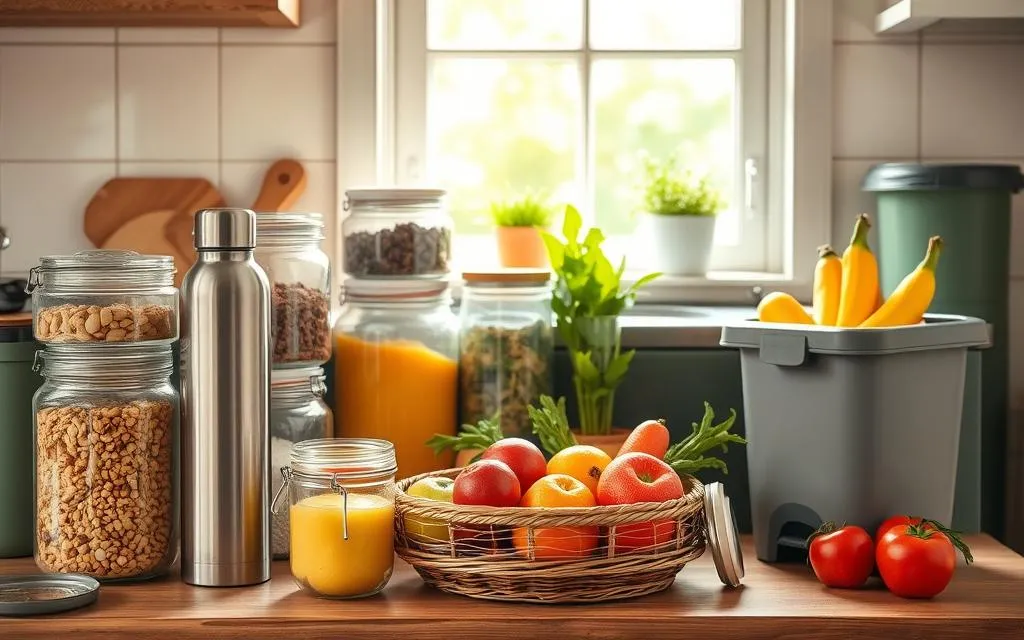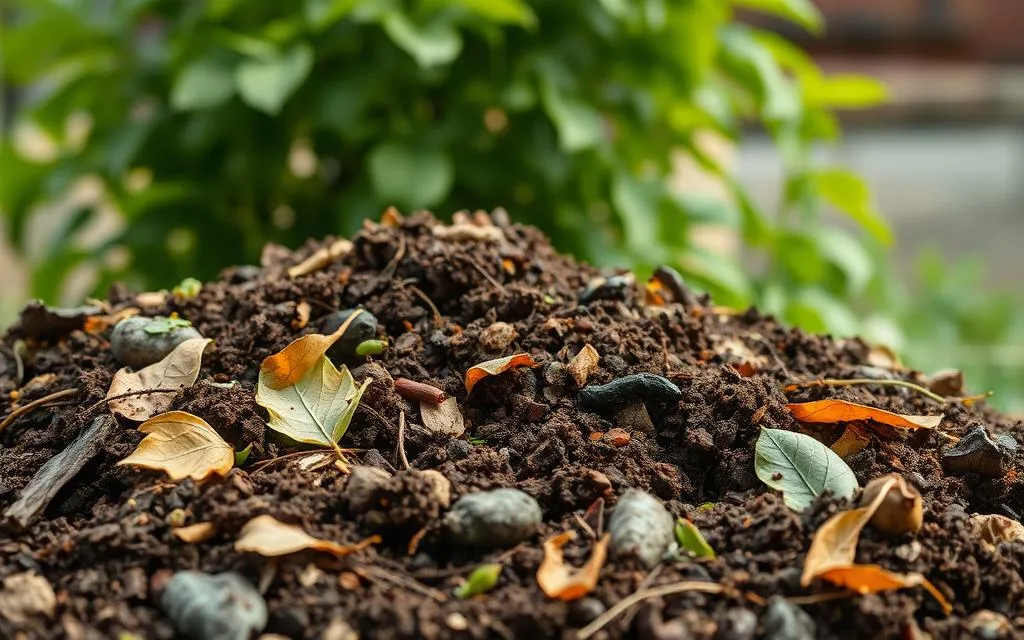Learn how to reduce plastic waste with easy steps to protect the environment, promote sustainability, and create a healthier planet for future generations.
We all want to make sustainable choices for a healthier planet. But how often do we think about our plastic waste? Every day, small habits add up, creating huge problems worldwide.
It’s time to look at how our daily actions affect the environment. Changing our habits can make a big difference. Let’s explore simple steps to reduce plastic and protect our planet.
Changing for the better doesn’t mean a complete overhaul. It’s about small, doable steps we can all take. By the end of this article, you’ll know how to make greener choices and cut down on plastic.
Table of Contents
ToggleUnderstanding the Impact of Plastic on the Environment
Plastic is very convenient, but its environmental impact is concerning. We see how plastic pollution harms wildlife conservation deeply.
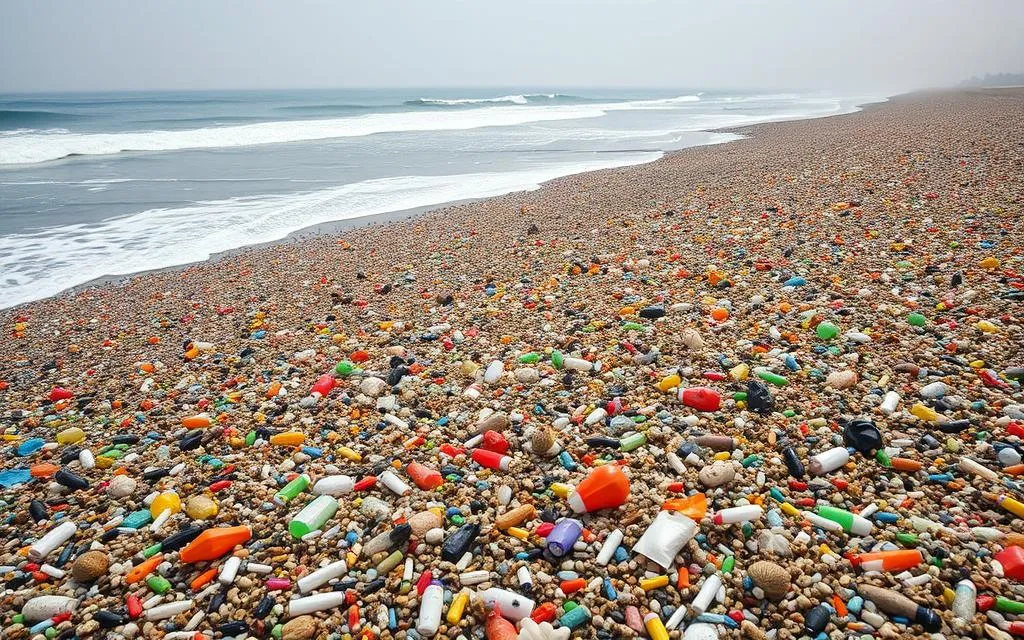
Why Plastic Pollution Is a Concern for Everyone
It’s a problem worldwide, affecting us all. Plastic doesn’t break down and ends up in our environment. It turns into tiny pieces called microplastics, harming both land and sea creatures.
Our daily actions add to this issue. We need to work together to cut down on plastic waste.
The Long-term Effects of Plastic Waste on Wildlife
Many marine animals, like seabirds and turtles, mistake plastic for food. This can be deadly. Animals on land also suffer, getting trapped in plastic or losing their homes.
This shows we must act fast to protect wildlife. We need strong wildlife conservation efforts to fight plastic waste’s harm.
Knowing about these problems helps us change. We must alter our ways and push for laws that protect our planet. By teaching others, we can move towards using less plastic and reducing its environmental impact.
Start with a Plastic Waste Audit
Starting a sustainable journey means understanding our plastic use. A waste audit helps us see what plastics we use often. This way, we can find the best places to cut down on plastic.
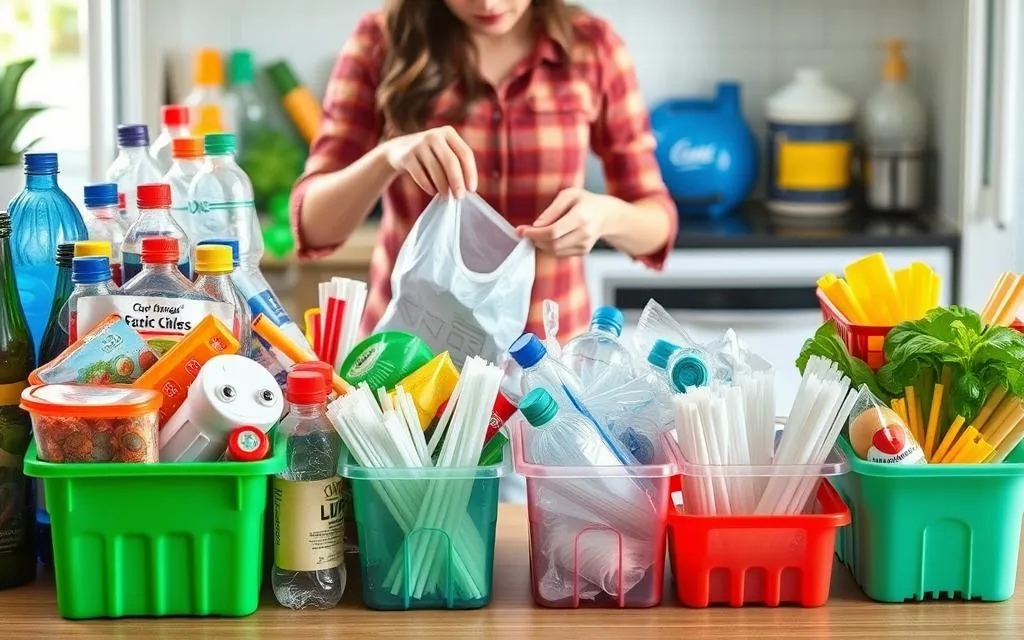
A waste audit is about collecting and sorting plastic waste from our homes. We can do this for a week or a month. The results help us make a plastic reduction strategy that fits our needs.
- Gather all plastic waste in a special bin for the audit period.
- Sort the plastic into types like food packaging, bags, and containers.
- See which types of plastic we use the most and think about how to use less.
After sorting, we’ll know what plastics we use most. This info helps us set goals to use less plastic. It also helps us choose better alternatives.
This effort is not just about less waste in landfills. It’s about changing our habits for the planet. By starting with a waste audit, we’re on our way to big changes. These changes will help our plastic reduction strategy succeed.
Eco-Friendly Shopping Habits to Minimize Plastic Usage
Working towards a greener lifestyle means adopting eco-friendly shopping habits. By choosing items with minimal packaging and using reusable bags, we can greatly reduce plastic waste. Let’s look at some steps we can take.
Choosing Products with Less Packaging
Choosing products with less packaging helps cut down on waste. It also pushes manufacturers to use more eco-friendly packaging. By picking items with less plastic, we support the move towards greener production.
Carry Reusable Bags and Containers When Shopping
Carrying reusable bags and containers is a simple yet powerful change. It helps us avoid single-use plastics for groceries, clothes, and more. These alternatives are key in reducing our plastic use.
| Shopping Habit | Impact on Plastic Reduction |
|---|---|
| Choosing bulk items | Reduces plastic packaging per item |
| Using cloth or mesh produce bags | Eliminates the need for plastic produce bags |
| Opting for products in cardboard or glass | Supports recycling and reusable options |
| Bringing reusable containers for leftovers | Prevents plastic waste in restaurants and cafes |
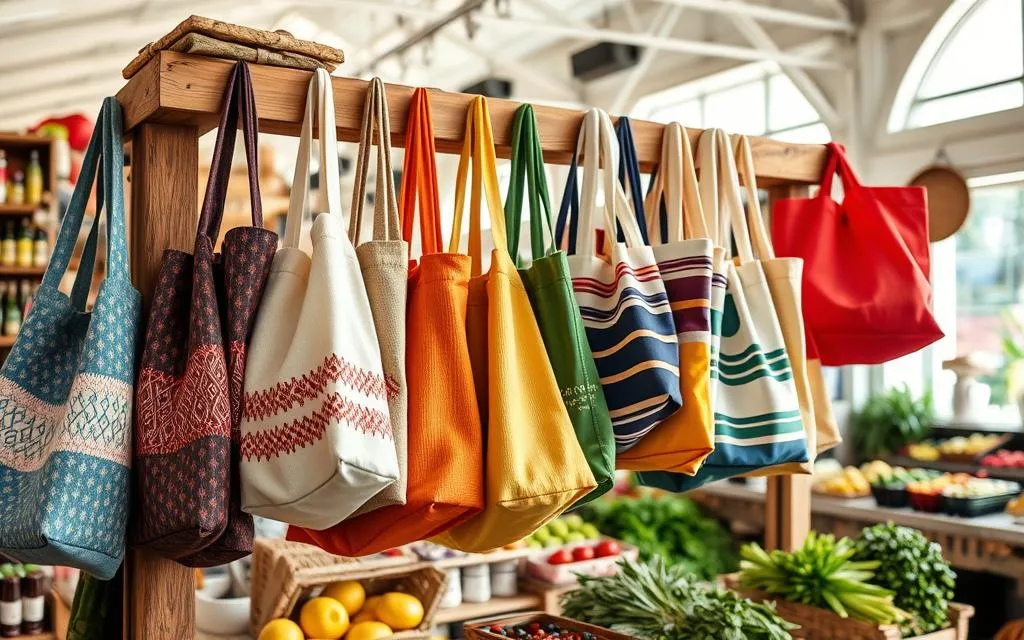
Switch to Sustainable Household Products
As we dive into eco-conscious living, making simple changes is key. Switching to sustainable products in our homes is a big step. It helps reduce our impact on the environment and moves us towards a greener lifestyle.
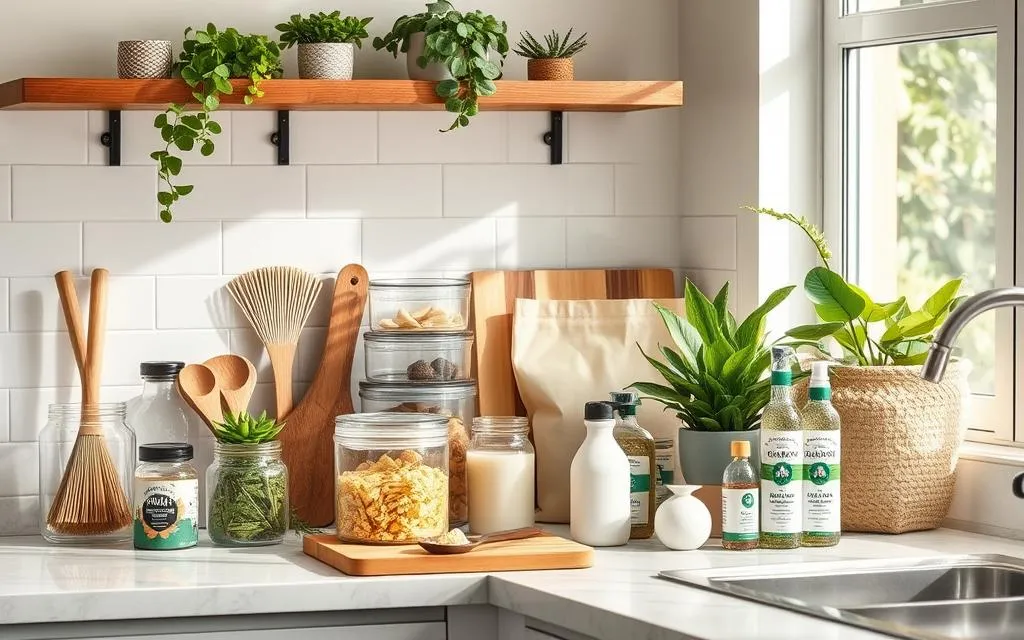
Understanding the many options available is important. We’ve put together a list of common household items and their eco-friendly alternatives. This guide aims to help you choose products that support eco-conscious living.
| Conventional Product | Sustainable Alternative |
|---|---|
| Plastic cling film | Bee’s wax wraps |
| Disposable cleaning wipes | Microfiber cloths |
| Synthetic sponges | Natural loofahs or cellulose sponges |
| Plastic toothbrushes | Bamboo toothbrushes |
| Plastic utensils | Biodegradable or compostable utensils |
Choosing sustainable products does more than cut down on waste. It also means safer, non-toxic items for our homes. By making these changes, you join a bigger movement towards eco-conscious living. Every small step can lead to big changes.
How to Reduce Plastic Waste by Rethinking Food Storage
Looking at our daily habits, especially food storage, is key to saving the environment. By picking sustainable food storage options, we can greatly reduce plastic waste. This helps us find and use reusable wraps and containers, which are better for our planet.
Investing in Reusable Wraps and Containers
Choosing reusable wraps is a great way to make our kitchens greener and more sustainable. These wraps are made from eco-friendly stuff like beeswax, silicone, and fabric. They’re a better choice than plastic wraps and zip bags because they can be used many times.
They also come in cool designs, making eco-friendly living stylish and easy.
Giving Up Single-Use Plastics for Food Preservation
Switching to non-disposable plastics is a big step towards sustainable food storage. Using items that last longer helps cut down on plastic waste at home. This change helps food last longer, cuts down on waste, and makes our homes cleaner and greener.
Choosing to use reusable wraps and eco-friendly containers might need a change in how we think and some upfront costs. But, the long-term gains like less waste, better food keeping, and a healthier planet are worth it. As we ditch plastic, our kitchens can become symbols of sustainability and mindful living.
Adopting a Zero Waste Lifestyle in Small Steps
Starting a zero waste lifestyle doesn’t mean changing everything at once. Small, achievable steps can make the transition easier and last longer. Here are some simple ways to start your zero waste journey.
- Start by looking at what you use every day. Find out which items are disposable and think about using something reusable instead.
- Try to waste less food by planning meals and saving leftovers. This way, you can enjoy food for longer.
- Switch to digital versions of things like bills and tickets. This cuts down on paper waste.
- Choose local shops and farmers’ markets. They often have less packaging and fresher products.
Every small change helps a lot in reducing waste. As these habits become part of your life, they lay the groundwork for a zero waste lifestyle. This not only helps us but also our planet.
| Current Practice | Zero Waste Alternative |
|---|---|
| Plastic grocery bags | Reusable cloth bags |
| Disposable water bottles | Reusable water bottles |
| Take-out food containers | Bring your own containers when possible |
| Plastic straws | Stainless steel or bamboo straws |
Choosing these alternatives not only reduces waste but also helps you think more sustainably. The path to a zero waste lifestyle is ongoing. Every small step counts and makes a big difference.
Embracing Reusable Alternatives to Common Plastic Items
As we move towards a greener lifestyle, every small change counts. Switching from disposable to reusable items is a big step. It helps the planet and makes our lives better.
The Impact of Saying No to Disposable Options
Choosing reusable over disposable items cuts down our environmental harm. It reduces landfill waste and saves resources. This change also pushes companies to make greener products.
Where to Find Plastic-Free Essentials
It’s now simpler to find eco-friendly products. More stores and online sites offer sustainable options. Start by checking local green stores or online shops focused on sustainability.
- Glass or stainless steel food containers instead of plastic ones
- Bamboo toothbrushes and cotton swabs
- Reusable shopping bags and produce bags
- Refillable personal care products
By choosing reusable and plastic-free items, we help our planet. Every time we say no to disposable items, we make a difference. Let’s make these changes together for a cleaner world.
The Role of Recycling in Reducing Plastic Waste
Recycling is key in our fight against plastic waste. It’s not just about using less plastic. Recycling helps manage the waste we’ve already made. We’ll look at how new recycling tech and good recycling habits help a lot.
Recycling is more than just throwing away waste. It stops plastic from ending up in landfills and oceans. By turning old plastic into new stuff, we use less new plastic. This makes a big difference for our planet.
- Understanding the Recycling Symbols: Not all plastics are the same. Knowing the recycling codes helps us sort better. This makes the recycling material better too.
- Local Recycling Guidelines: Every place has its own recycling rules. Following these rules makes recycling work better. It also keeps the recycling clean.
New tech has made recycling better. Now, we can recycle more kinds of plastic. This means we can recycle more plastic and make better products from it.
| Recycling Technology | Plastic Types Processed | Impact on Plastic Reduction |
|---|---|---|
| Advanced Mechanical Recycling | PET, HDPE | Highly effective in reducing plastic volume in landfills |
| Chemical Recycling | Mixed Plastics | Breaks plastic down at the molecular level for pure output |
| Energy Recovery | Non-recyclable Plastics | Converts waste into energy, reducing plastic pollution |
By recycling well, we take care of waste and cut down on plastic pollution. Recycling is a big part of reducing plastic. Let’s all do our part to recycle more.
Involving the Community in Plastic Waste Reduction
As we wrap up our talk on reducing plastic waste, we focus on a key part: community involvement. While personal actions are important, a community’s effort can make a big difference. By working together, we can make sustainable living the standard, not just an option.
Getting involved in local waste reduction programs is a great start. Imagine the impact when people come together for a cause. From cleaning up beaches to pushing for plastic bag bans, every action counts. When we unite, businesses and leaders take notice, leading to big changes in our communities.
It’s time to spread the word about living green. Let’s plan community cleanups and workshops to teach about plastic waste. Supporting stores that offer plastic-free options and praising eco-friendly businesses is also key.
Our actions can inspire a community to join us in making a difference. Together, we can keep our world healthy and sustainable for the future.
Want to take action for a plastic-free future? Visit envirocarecentral.com for practical tips on how to reduce plastic waste and make a real difference today!


